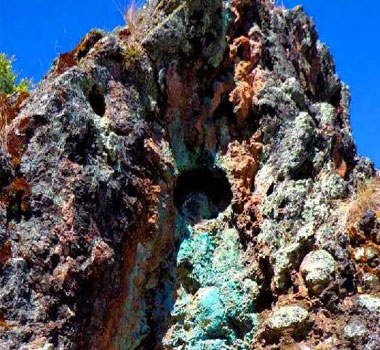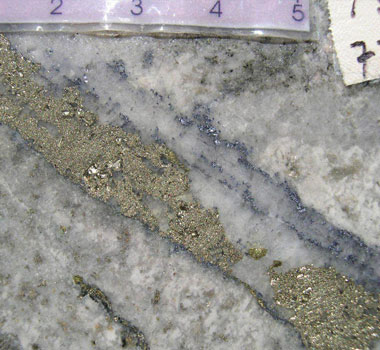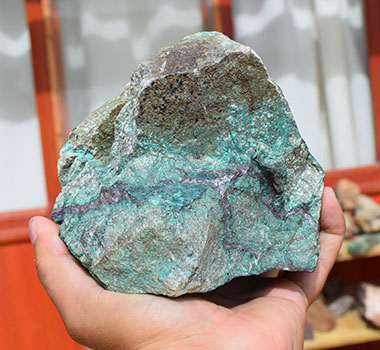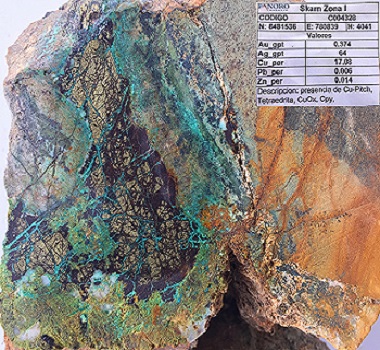Documento Relacionado
Vancouver, B.C., May 2, 2016 - Panoro Minerals Ltd. (TSXV: PML, Lima: PML, Frankfurt: PZM) ("Panoro", the "Company") is pleased to announce that it has received the results of an independent Preliminary Economic Assessment ("PEA") of the Company's 100% owned Antilla project in Peru. The Antilla project is a copper-molybdenum porphyry deposit, located 140 km south west of the city of Cuzco, in the Apurimac region in Southern Peru.
Highlights
- Pre-tax NPV(7.5%) is US$ 491 million, IRR is 22.1% and payback is estimated at 3.3 years
- After-tax NPV(7.5%) is US$ 225 million, IRR is 15.1% and payback is estimated at 4.1 years
- Conventional open pit mining and flotation processing
- Design throughput of 40,000 tonnes per day with an operational life of mine of 24 years
- low waste to mill feed ratio of 0.85:1
- Average annual payable copper of 81 million pounds
- Average annual payable molybdenum of 1.9 million pounds
- Average direct cash costs (C1) of US$1.83 per pound of payable copper, net of by product credits
- Initial project capital costs of US$ 603 million, including contingencies
- Good potential for discovery of additional mineralization adjacent to the current mineral resource area.
The PEA was prepared by SRK Consulting (Canada) Inc. ("SRK") and Moose Mountain Technical Services Ltd. ("MMTS") in accordance with the definitions in Canadian National Instrument 43-101. The PEA is based on a Mineral Resource estimate completed by Tetra Tech Inc. ("Tetra Tech") in December 2013, based on 2,919 metres of drilling from legacy campaigns (2003-5), 9,130 metres of drilling by Panoro (2008), and 2,242 metres of drilling during a joint venture agreement with Chancadora Centauro SA (CHC) in 2010. The Mineral Resource estimate includes primary and supergene sulphides, as well as oxide copper.
The PEA is considered preliminary in nature. It includes Inferred Mineral Resources that are considered too speculative to have the economic considerations applied that would enable classification as Mineral Reserves. There is no certainty that the conclusions within the PEA will be realized. Mineral Resources that are not Mineral Reserves do not have demonstrated economic viability.
Luquman Shaheen, President & CEO of Panoro Minerals states, "We are pleased to complete another milestone for the Company. The Antilla Copper/Molybdenum Project PEA is an important addition to Panoro's Cotabambas Copper/Gold/Silver Project, for which the PEA was completed in late 2015; that project is located 90 km to the northeast. Panoro continues to build onto its unique position with two important copper projects located in the key copper development district in Peru, where the national strategic objective includes the rapid development of the country's copper mining industry. The Antilla Project PEA results demonstrate an attractive open pit, low strip, long life copper mine with relatively moderate initial capital costs for a project of this scale and mine life. The updated resource estimate included in the PEA has upgraded more of the resource to indicated category which should help minimize additional drilling costs to move the project towards a feasibility level. Panoro's two advanced projects together have an estimated pre-tax NPV7.5% of over $US 1.5 billion, with combined annual production of 421,000 tonnes of concentrate, containing annual payable metals of 236 million pounds of copper, 1.9 million pounds of molybdenum, 95,100 ounces of gold and 1,018,000 ounces of silver. The smaller scale of the Antilla Project, in addition to reducing the stand alone development costs, presents Panoro with additional strategic and financing alternatives to fund advancement of its other projects including the Cotabambas Project."
Economics
The table below summarizes base case economic metrics for the project as well as its sensitivity to the price of copper:
| Copper Price ($/lb) | Before Tax* | After Tax | ||||||||
|---|---|---|---|---|---|---|---|---|---|---|
| NPV 5% (million USD) | NPV 7.5% (million USD) | NPV 10% (million USD) | IRR (%) | Payback (Years) | NPV 5% (million USD) | NPV 7.5% (million USD) | NPV 10% (million USD) | IRR (%) | Payback (Years) | |
| 2.75 | 389 | 261 | 161 | 16.2 | 4.0 | 163 | 78 | 11 | 10.5 | 4.8 |
| 3.00 | 676 | 491 | 350 | 22.2 | 3.3 | 348 | 225 | 131 | 15.1 | 4.1 |
| 3.25 | 964 | 721 | 538 | 27.7 | 2.7 | 529 | 369 | 248 | 19.0 | 3.6 |
* Excluding Peru statutory charges, i.e. profit sharing, regulatory fees, mining royalty, special mining tax, and income tax
** The economic results are based on the mill feed tonnages in the selected ultimate pit. The mill feed tonnages include Inferred Resources. The reader is cautioned that Inferred Resources are considered too speculative geologically to have the economic considerations applied to them that would enable categorization as Mineral Reserves. Mineral Resources that are not Mineral Reserves do not have demonstrated economic viability.
Note: base case at Cu=$US 3.00 in bold, all cases include Mo=$US 12.00
Project economics were estimated on the basis of long term metal price forecasts derived from prices periodically published by large banking and financial institutions and included copper at $3.00/lb, and molybdenum at $12.00/lb.
Mineral Resources
The PEA was based on a Mineral Resource model prepared by Tetra Tech, which is documented in a technical report filed on Sedar, dated December 16, 2013.
Mineral Resources were estimated by Qualified Person Paul Daigle, PGeo. (APGO #1592). A block model was generated with grade estimation constrained by modeled mineralization wireframes. Mineralization is mined from an open pit and treated using conventional flotation and hydrometallurgical flow sheets. Copper equivalent (CuEq) cut-offs were used to report the mineral resource. Metal prices: copper - US$3.25/lb and molybdenum -- US$9.00/lb and metallurgical recoveries: copper - 90% and molybdenum - 80% were applied in the equivalency calculation.
During the current PEA, Tetra Tech re-classified the mineral resources and also revised the pit shell used to constrain the mineral resource for reporting, using more current pit optimization parameters. The estimation parameters for the 2015 mineral resource model are identical that of 2013.
The updated Mineral Resource has an effective date October 19, 2015 and is tabulated in Table 2.
Table 2. Mineral Resource Statement*, Antilla Project, Peru, Tetra Tech Inc., October 19, 2015
| Domain | Quantity | Grade | ||
|---|---|---|---|---|
| '000 tonnes | Cu % | Mo % | CuEq% | |
| Indicated | ||||
| Overburden/Cover | 5,600 | 0.25 | 0.01 | 0.28 |
| Leach Cap | 13,400 | 0.25 | 0.01 | 0.27 |
| Supergene | 168,900 | 0.41 | 0.01 | 0.42 |
| Primary Sulphides | 103,900 | 0.24 | 0.01 | 0.26 |
| Total Indicated | 291,800 | 0.34 | 0.01 | 0.36 |
| Inferred | ||||
| Overburden/Cover | 500 | 0.22 | 0.009 | 0.24 |
| Leach Cap | 13,400 | 0.21 | 0.008 | 0.22 |
| Supergene | 25,900 | 0.34 | 0.008 | 0.36 |
| Primary Sulphides | 50,700 | 0.24 | 0.007 | 0.25 |
| Total Inferred | 90,500 | 0.26 | 0.007 | 0.28 |
* Mineral resources are not mineral reserves and have not demonstrated economic viability. All figures have been rounded to reflect the relative accuracy of the estimates. Reported at a cut-off grade of 0.175 CuEq%; assuming an open pit extraction scenario, a copper of US$3.25 per pound and a molybdenum price of US$ 9.00 per pound, and a metallurgical recovery of 90 percent for copper and 80 percent for molybdenum.
The revised reporting methodology for the 2015 Mineral Resource statement has resulted in a positive and significant net redistribution of material from Inferred to Indicated compared to the 2013 mineral resource statement. A detailed analyses of the 2013 to 2015 mineral resource reconciliation will be provided in the technical report being prepared to support the PEA. Primary reasons for the change include a revised pit shell used to constrain mineral resource reporting, a drop in reporting cut-off grade from 0.20 CuEq% to 0.175CuEq% and the unique distribution of grade within the deposit.
Table 3 tabulates the variance between the 2013 and 2015 mineral resource statements, which highlights the net increase in Indicated mineral resources at the expense of Inferred mineral resources. The small decreases in metal grades, due to the lower cut-off grade, are offset by large increases in tonnage; therefore this update reports a net increase in metal over previous estimates.
| Domain | Quantity | Grade | ||
|---|---|---|---|---|
| '000 tonnes | Cu % | Mo % | CuEq% | |
| Indicated | ||||
| Overburden/Cover | 22% | -7% | 0% | -7% |
| Leach Cap | 54% | -11% | 10% | -10% |
| Supergene | 27% | -9% | -20% | -9% |
| Primary Sulphides | 144% | -20% | -10% | -19% |
| Total Indicated | 55% | -16% | -15% | -15% |
| Inferred | ||||
| Overburden/Cover | 101% | -8% | -10% | -8% |
| Leach Cap | 59% | -5% | -20% | -8% |
| Supergene | -47% | 3% | -20% | 6% |
| Primary Sulphides | -42% | -8% | -30% | -7% |
| Total Inferred | -38% | -6% | -26% | -5% |
* Reconciliation: 22% = (2015-2013)/2013
Mining and Processing
The PEA incorporates an open pit mining operation using conventional truck and shovel methods. The estimated 24 year life of mine includes 350 million tonnes of mill feed plus 297 million tonnes of waste rock resulting in an average waste:mill feed ratio of 0.85:1. The average life of mine mill feed grade is 0.31% copper and 0.009% molybdenum. The mill throughput is planned at 40,000 tonnes per day through the processing plant that will be located approximately 1 km to the West of the Antilla ultimate pit limit. Approximately half of the wasterock will be used for construction of the Tailings Storage Facility (TSF) with the remaining wasterock placed in storage areas around the pit limit and within the pit.
The sub-set of the Mineral Resources contained within the ultimate pit and included in the mine plan is 291.1 million tonnes averaging 0.322% Cu, 0.0089% Mo classified as Indicated Resources and 59.8 million tonnes averaging 0.249% Cu, 0.0071% Mo classified as Inferred Resources. The reader is cautioned that Inferred Resources are included in the mine plan but are considered too speculative geologically to have economic considerations applied to them that would enable categorization as Mineral Reserves. There is no certainty that Inferred Resources will be upgraded to Reserves. Mineral Resources that are not Mineral Reserves do not have demonstrated economic viability.
Table 4 summarizes the production parameters:
| Total Mill Feed Material* | 350.4 million tonnes** | |
| Average Processing Rate | 40,000 tonnes per day | |
| Life of Mine (LOM) Strip Ratio | 0.85 | |
| Copper | Molybdenum | |
|---|---|---|
| Average Mill Feed Grade | 0.31% | 0.009% |
| Average Process Recoveries | 84.5% | 67.4% |
* The mill feed tonnes in the mine plan include Inferred Resources. The reader is cautioned that Inferred. Resources are considered too speculative geologically to have economic considerations applied to them that would enable categorization as Mineral Reserves. There is no certainty that Inferred Resources will be upgraded to Reserves. Mineral Resources that are not Mineral Reserves do not have demonstrated economic viability.
** The cut-off grade used to calculate the mill feed is NSR>=6.1 NSR is calculated using the following formula:
NSR = [Cu grade (%) * Cu process recovery (%) * 57.76] + [Mo grade (%) * Mo process recovery (%) * 203.93]. The total mill feed tonnes do not include 0.5 Mt of stockpiled material that will not be processed at the end of the mine life since this material forms the base of the stockpile pad.
The run of mine mineralized material will feed a gyratory crusher ahead of a conventional SAG and ball mill grinding circuit. A bulk copper-molybdenum concentrate will be recovered in rougher and scavenger flotation stages. Following regrinding, molybdenum will be separated from the bulk concentrate in three or more stages of cleaner flotation. Both concentrates will be thickened and filtered while the tailings will be thickened prior to being pumped to the TSF.
For the two main zones (Supergene and Primary Sulphide), the copper concentrate will be 20% to 30% Cu, a clean concentrate free of penalty elements and precious metal content below payable levels. The molybdenum concentrate will be 32% to 40% Mo; future testwork will determine if further processing is required to reduce the copper and zinc levels. Both concentrates will be transported off site via truck with the copper concentrate shipped out of the port of Marcona, in Nazca province.
Metallurgical testwork was completed in 2013 by Certimin Laboratories S.A. in Lima, Perú on individual samples of Supergene and Primary Sulphide mineralised material. No metallurgical testwork has been conducted on the Cover or Leach Cap domains.
Table 5 summarizes the expected recoveries of the four mineralized domains, with the Cover and Leach Cap performance assumed to follow the main domains based on similar copper mineralogy/speciation.
| Mineralized Domain | Cu Recovery (%) | Mo Recovery (%) |
|---|---|---|
| Cover* | 80 | 65 |
| Leach Cap* | 75 | 65 |
| Supergene | 85 | 70 |
| Primary Sulphide | 85 | 65 |
* QP estimates - no supporting testwork completed
Projected production of payable metals is summarized in Table 6.
| Annual Average | Life of Mine | |
|---|---|---|
| Copper (Mlbs) | 81.0 | 1,944 |
| Molybdenum (Mlbs) | 1.9 | 44 |
Tailings
Flotation tailings will be pumped as a low solids content slurry to the TSF and discharged via spigots. The TSF containment dam will be constructed predominantly from wasterock produced from the mining activities and will include a geomembrane liner on the upstream face. Additional zones within the containment dam will be constructed with borrow material. Dam construction will be staged over the life of the mine using the downstream construction method. Reclaim water from the TSF will be circulated back to the mill. At closure, the tailings surface will be covered with a geosynthetic membrane liner and a growth medium, and the downstream face of the containment dam will be covered with a growth medium.
Capital and Operating Costs
The projected capital and operating costs for Antilla over a 2 year construction period and 24 year operating mine life are summarized in the tables below.
Table 7. Summary of Antilla Initial Capital Cost Estimates (US$ millions)
| Item | Cost (US$ million) |
|---|---|
| Mine Equipment | 51 |
| Mine Development | 55 |
| Process Plant | 187 |
| Tailings Storage Facility | 18 |
| Infrastructure | 85 |
| Subtotal | 396 |
| Owners Cost | 28 |
| Indirect Costs | 82 |
| Subtotal | 506 |
| Contingencies | 97 |
| Total Initial Capital Cost | 603 |
Power will be supplied via a 50 km long power line connected to the national grid at the Cotaruse substation in the district of Chalhuanca to the southwest of the Antilla project. Copper concentrate will be trucked by contractor from the mine site to the port of Marcona, in Nazca province, along existing road networks.
| Item | Cost (US$ million) |
|---|---|
| Mine Equipment | 133 |
| Tailings Storage Facility | 181 |
| Infrastructure | 10 |
| Total Sustaining Capital Cost | 324 |
| Mine Closure | 92 |
| Sustaining Capital and Closure Cost | 416 |
Table 9. Antilla On-site Operating Costs (US$ per tonne milled)
| Item | Cost (US$ million) |
|---|---|
| Mining Cost | 3.57 |
| Processing Cost | 4.78 |
| G&A Costs | 0.75 |
| Total On-site Operating Cost | 9.10 |
C1 and C2 cash costs (as defined by Brook Hunt) per pound of payable copper are listed in the table below.
Table 10. Antilla Average Cash Costs (US$) per lb Payable Copper
| Item | Cost (US$ million) |
|---|---|
| C1 - Direct Cash Cost | 1.83 |
| C2 - Production Cost | 2.35 |
Opportunities for Project Growth and Enhanced Economics
- Tetra Tech recommends that further investigation of the Antilla deposit is warranted and necessary. There is potential to add new mineral resources at depth and in the Northeast and Southeast sides of the pit shell. Tetra Tech recommends that additional drilling be carried out to reduce the drill spacing ion those zones with copper mineralization, where drill spacings distances are greater than 100 m. Additional drilling will determine, with greater confidence, both the continuity and extents of copper mineralization within and outside of the known deposit.
- Tetra Tech recommends an extension of the current exploration grid to include the West Block, North Block, Middle Block and Chabuco exploration targets. Tetra Tech recommends continued geochemical sampling and geophysical surveys over these areas located next to the current mineral resources.
- Mill feed hardness could be consistently soft through mine life and lower crushing and grinding power requirements or alternately allow the plant to operate at higher capacity
- Potential to use a contractor mining fleet and reduce initial capital costs
- Potential to use larger equipment sizes and reduce mining costs
- Considering the very preliminary metallurgical testwork undertaken on the project to date, there is potential to increase recoveries with additional metallurgical testing and to improve discrimination between metallurgical types within the deposit
Future Work
Further work leading to a Pre-Feasibility Study is recommended and will include drilling, mineral resource modeling, metallurgical testwork, engineering and marketing studies, hydrological and geotechnical analysis, as well as various baseline environmental and archeological studies. In addition, exploration work will be recommended over the other targets in the vicinity of the known deposits.
Tailings
Comprehensive tailings and waste rock geochemical testing is required to confirm whether additional seepage control and mitigation measures may be required and whether there may be an opportunity to eliminate the need for a geosynthetic membrane in the closure cover system.
Geotechnical characterization of the tailings storage facility dam foundation and basin are required to confirm the proposed design. Borrow material and waste rock geotechnical characterization studies are also required. There are alternative areas for tailings storage inside and outside the property and a study of analysis of alternatives will be developed.
Environment & Permitting
Existing environmental liabilities associated with the project are restricted to those expected to be associated with an exploration-stage project, and include drill sites and access roads. Additional Environmental Baseline studies should be conducted to collect site data including surface water quality, archeology, aquatic and terrestrial biology, flora, fauna, and additional geochemical characterization of mine waste materials. This information will inform a comprehensive Environmental Impact Study.
Technical Reporting
The complete technical report documenting the PEA will be filed within 45 days of this news release and will be available on Panoro's website and on SEDAR. The technical report will be authored by the following Qualified Persons:
| Qualified Person | Firm | PEA Area | Professional Affiliation (and registration number) |
|---|---|---|---|
| Paul Daigle, PGeo | Tetra Tech Inc. | Geology, resources | APGO (#1592) |
| Jesse Aarsen, PEng | Moose Mountain Technical Services Ltd. | Mining | APEGBC (#38709) APEGA (#74969) |
| Adrian Dance, PEng | SRK Consulting (Canada) Inc. | Mineral processing | APEGBC (#37151) |
| Maritz Rykaart, PEng | SRK Consulting (Canada) Inc. | Tailings, environmental | APEGBC (#28531) |
| Goran Andric, PEng | SRK Consulting (Canada) Inc. | Infrastructure | PEO (#100103151) |
| Brian Connolly, PEng | SRK Consulting (Canada) Inc. | Economic analysis | PEO (#90545203) |
| Luis Vela, CMC | Panoro Minerals Ltd. | Exploration, mineral tenure, permits | CMC (#0173) |
Information in this news release, which is derived from the PEA, has been reviewed by the Qualified Persons of Tetra Tech, Moose Mountain Technical Services, and SRK.
About Panoro
Panoro is advancing its unique portfolio of copper and gold projects in the key Andahuaylas-Yauri belt in south central Peru, including its advanced stage Cotabambas Copper-Gold-Silver-Molybdenum and Antilla Copper-Molybdenum Projects.
Since 2007, the company has completed over 70,000 m of exploration drilling at these two key projects leading to the delineation of mineral resources of:
| Cotabambas Cu/Au/AG Project: | Indicated Resource 117.1 Mt @ 0.42% Cu, 0.23g/t Au, 2.74 g/t Ag & 0.001%Mo (@0.2% Cueq cutoff) Inferred Resource 603.5 Mt @ 0.31% Cu, 0.17g/t Au, 2.33 g/t Ag and 0.002 %Mo (@0.2% Cueq cutoff) (Tetra Tech, with an effective date of October 2013) | |
| Antilla: Cu/Mo Project | Indicated Resource 188.5 Mt @ 0.40% Cu and 0.009% Mo (@0.2% Cueq cutoff) Inferred Resource 145.9 Mt @ 0.28% Cu and 0.009%Mo (@0.2% Cueq cutoff) (Tetra Tech, with an effective date of December 2013) Indicated Resource 291.8 Mt @ 0.34% Cu and 0.009% Mo (@0.175% Cueq cutoff) Inferred Resource 90.5 Mt @ 0.26% Cu and 0.007%Mo (@0.175% Cueq cutoff) (*Tetra Tech, with an effective date of October 2015) Note: *This material was not previously disclosed as it was not considered material for the project. |
Exploration at the Cotabambas Project has focused on the Ccalla and Azulccaca deposits. However, at least eight other porphyry and skarn target zones have been identified within the company's Cotabambas mineral concession blocks. Additional exploration including drilling at these targets is planned.
Additional resource growth potential at the Antilla Project has been identified and additional exploration will be included in the advancement of the project.
In addition to the Cotabambas and Antilla Projects, Panoro's portfolio includes a number of earlier stage projects in primarily the same region of south central Peru. Peru's national objective of doubling copper production together with the development of the many copper projects in the region, together with the private and public investments into rail, road, power generation and transmission and port infrastructure are leading to the rapid growth of an important global center for copper production. Panoro's large portfolio is situated here along with the Las Bambas, Tintaya, Antapaccay, Haquira, Constancia, Las Chancas and Trapiche projects all of which are either in exploration stage, construction or already in production.
Luis Vela, a P. Geo Qualified Person under National Instrument 43-101, has reviewed and approved the scientific and technical information in this press release.
On behalf of the Board of Panoro Minerals Ltd.
Luquman A. Shaheen, M.B.A., PEng, P.E.
President & CEO
FOR FURTHER INFORMATION, CONTACT: Panoro Minerals Ltd.
Luquman A. Shaheen, President & CEO
Phone: 604.684.4246
Fax: 604.684.4200
Email: info@panoro.com
Web: www.panoro.com
This release was prepared by management of the Company who takes full responsibility for its contents. Neither TSX Venture Exchange nor its Regulation Services Provider (as that term is defined in the policies of the TSX Venture Exchange) accepts responsibility for the adequacy or accuracy of this release.




